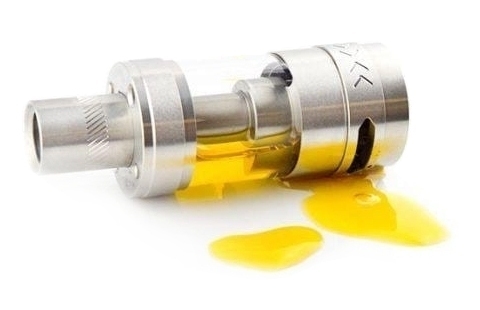Home Creme de Vape Blog Why is my tank leaking?
Why is my tank leaking?

A leaking tank is something we've all experienced, but it's usually pretty easy to fix if you can identify the reason for the leakage.
Leakage happens when your atomiser is flooded and the e-liquid will usually find its way out of the airflow system. If you've got a tank which is flooding, gurgling or leaking, you'll have a poor vaping experience, and you'll want to try to fix it because it could harm your device or cause it to fail if it reaches the electronics.
The first thing to understand is that tanks and heads designed for Direct Lung (DL) vaping are generally designed for a thicker, higher VG liquid and usually feature larger wicking holes to wick liquid faster to the coil to keep up with higher coil temperatures/wattages. If you're using too thin a liquid in a DL tank, you are likely to experience leaking. Mouth-to-lung (MTL) tanks usually have smaller wick holes, are used at much lower wattages and tend to wick juice slower to avoid flooding. Typically most MTL tanks will not cope with a very high VG liquid because of this. So if you're using the wrong liquid for the type of tank or head, you're likely to experience either leakage, or the opposite - poor wicking and dry coils prone to burning.
Other than trying to use the wrong liquid or tank for your vaping style, common reasons for flooding include:
- Incorrect tank assembly or damaged/missing parts
It sounds obvious, but it's important to ensure your tank and head are all put together correctly, because improper assembly commonly causes leakage. If any of the parts are cross-threaded, improperly assembled, damaged or cracked, or if any of the seals are damaged or missing, it will cause leakage.
- Liquid or condensation in the chimney
On some tanks, it's easy to accidentally get juice in the central airflow tube which leads from the mouthpiece down to the coil when re-filling. Sometimes cooled vapour condenses here and some tanks need the inside of the chimney cleaned regularly. If you find you are experiencing a lot of condensation build-up, try altering your vaping style a little, by taking your finger off the fire button a bit before you've finished your inhalation. This should ensure the entire vapour production from that activation has been inhaled and no vapour residue has been left in the chimney to condense back into liquid.
- Your e-liquid is a little too thin
If your liquid has a higher percentage of PG, you may want to move to one with a bit more VG, or even add a little VG yourself. This should slow down the wicking and hopefully be a little more effective at preventing flooding. This is especally important if using a tank designed for DL vaping, as the wicking holes in the coil are usually much larger so thinner liquids will leak through quicker.
- The coil needs changing
Most vapers find they get 5-10 days of good use from a coil depending on their vaping frequency and style. Your mileage may vary, however, you will want to change your coil whenever you notice a change in taste, vapour, performance or wicking, and a flooded or an overly dry coil can both be signs that the coil is on its way out.
- Filling technique
Some top-fill tanks are more prone to leakage during or after filling. Every time you open a top-fill tank to fill it, the pressure is changed inside the tank, and tanks which have a top cap that is completely removed to fill can be prone to trapping air and pushing more liquid into the coil when you screw the cap back on after filling. Some manufacturers have cleverly designed caps which work to prevent this and others have created innovative liquid control solutions which allow you to completely close off the liquid feeding to eliminate flooding when the cap is opened. If you have liquid control, close the liquid feeding off - if you don't, then try closing the airflow off before you open the tank to fill it - this helps in many cases, but this isn't a foolproof fix. Get into the habit of leaving a little pocket of air at the top when filling rather than trying to fit the maximum amount of liquid in the tank.
- The airflow setting might be set too tight
If your airflow setting is too restricted, this can create a stronger suction effect, which causes the tank to feed liquid to the coil faster than it can be vaporised. If your tank has adjustable airflow, try opening it up to an airier setting to see if the flooding reduces. You may be "pulling" a bit too strongly - in some tanks, the airflow setting and the strength of the suction can both cause too much liquid to be brought to the coil, thus promoting flooding. Try a softer draw or an airier airflow setting.
- Inappropriate power setting
You might not be using a high enough power setting to vaporise all the liquid coming to the coil. This is particularly pertinent if you are using a tank designed for DL vaping. Coils below 1 ohm are mostly used for DL vaping, at higher power (usually above 25W), with thicker juice and with unrestricted airflow. If you're using a power setting lower than is recommended for the coil you're using, it may be feeding more liquid to the coil than can effectively be vaporised. Raise your power setting, or switch to a higher resistance coil.
- Improper wicking (rebuildables only)
If you're using a rebuildable atomiser, you'll need to ensure you're following the manufacturer's recommendations for wicking. Sometimes working out the ideal wick size and placement takes a bit of trial and error to get the best results for your particular atomiser and vaping style.
- Tank has been left for too long between uses
Most tanks will continue to wick the juice to the coil even when the tank is sitting idle. If you don't use your tank frequently, you'll usually find it floods more easily. If you're going to leave your tank unused for a couple of days or longer, it's best to empty it out and use a new coil next time. Some tanks (with a bottom coil and airflow) can be stored upside down for a few days with e-liquid in them to prevent wicking and flooding, but it's not recommended for more than a few days as you don't actually want your coil to completely dry out between uses.
- Tank has been left on its side
Some tanks are much more prone to leakage if they are left on their side between uses, or overnight. Try to keep your tank upright during vaping, and when its not in use.
What to do once your coil has flooded or leaked
Different methods work for different tanks - try one or more of the following to recover a flooded head.
- Take your tank off the device, and sharply blow down the mouthpiece to push the excess liquid out through the airholes into a tissue.
- Roll part of a tissue up and insert it into the mouthpiece and invert the tank to try to clear the flood out of the top. Best to also clean the inside of the chimney after this method with another piece of rolled-up tissue.
- If the coil head sits inside a base, take the head out and use a tissue or cotton bud to clean out the base. Remove any visible excess liquid on the outside of the head and also clean the inside of the chimney with a rolled-up tissue.
Some heads are just more flood prone than others, particularly if you have quite a heavy “draw” and some may continue to flood even after blowing out, especially if the tank or coil isn't suited to your vaping style or your power settings are outside those recommended by the manufacturer.




















